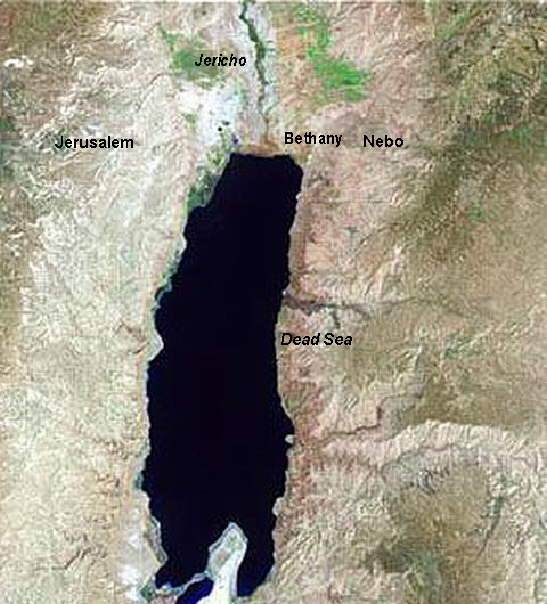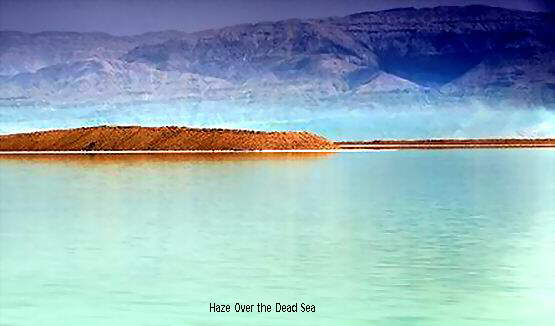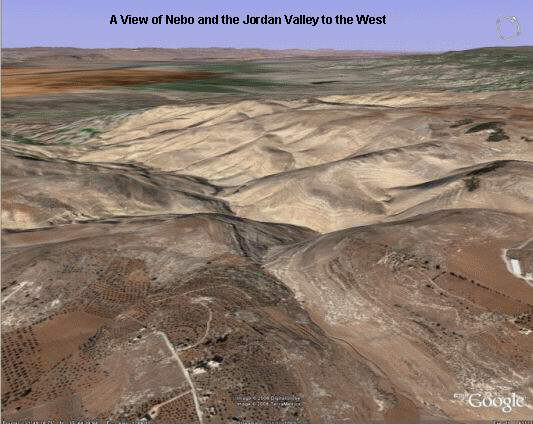|
|
The Baptism Of Jesus Christ And The Winter Solstice July
2010 By Steve Santini In a court of law the answers to the questions of where, when and what are paramount in determining the truth of a matter. More so, for the the seeker in scripture, the where, what and when of an event broadens and deepens its significance To the Easterner, event locations were symbolically important. For example,Pisgah was a revered mountain range because Moses viewed the promise land from its peak Nebo before dying. So other spiritual events in that area would be considered more significant to Easterners. And events were significant according to future events that were prophesied to occur at the locations. Along the east west line connecting Nebo to Jerusalem, the Old Testament prophet Zechariah prophesied the Mount of Olives would split offering a river valley to refresh the Dead Sea. Then from the heavenly temple fresh water would flow east into the Dead Sea at the future millennial kingdom. The timing of an event in accordance with historical events that occurred on the same day or in the same time frame in previous generations also attributed a deeper meaning to a current event. The Roman general Titus used this aspect of Eastern thought for Rome's psychological humiliation of the rebellious Jews when he sacked and destroyed the Jerusalem temple of Herod in 70 AD on the same day that the Babylonian king Nebuchadnezzar had destroyed the Jerusalem temple of Solomon in 586 BC. Even greater meaning was attributed to an event that corresponded to a significant celestial event. The baptism of Jesus was and is highlighted by its location with a number of other significant historical events in the vicinity and by the timing of its occurrence. Scriptures are quite clear on the location where Jesus was baptized. These things were done in Bethany beyond Jordan, where John was baptizing. John 1:36 (Aramaic and Earliest Greek Manuscripts)
Being beyond the Jordan, this Bethany is not the same as the Bethany two miles from Jerusalem where Lazarus, Mary and Martha lived. This Bethany, on the east side and near the mouth of the Jordan River, was the lowest town in the world. The village, at a Jordan River ford, sat below the western end of an east west spur off the Mountains of Abarim. This ridge named Pisgah descended gradually east to west from Abarim's 2,600 foot peaks until it rapidly dropped off into the east side of the Jordan River Valley. Below the northern flank of Pisgah, a route, from the King's Highway on the far side of the Mountains of Abarim, descended into the valley through Bethany, crossed the Jordan at its nearby ford and ascended up the western side of the valley towards Jerusalem. Just to the south of Pisgah a stream flowed for miles down through narrow chasms from the spring of Moses below the flank of Nebo to enter the valley and flow into the Dead Sea near the mouth of the Jordan River. In contrast to the semi arid mountains and rocky terrain large willow trees grew along its narrow banks. In later history the area where it flowed in the valley to the Dead Sea was known as the place of the willows. A short distance to the south of Bethany laid the Dead Sea, the world's most saline body of water. As its waters evaporated, salts, including bromine, entered the air producing a haze over the sea. This salt in the air relaxed the respiratory system providing a balm to inhabitants dwelling nearby. Under certain conditions the haze provided an ethereal appearance in views across the sea.
Due to Bethany's elevation 1,300 feet below sea level its winters were comfortable. Herod had built several winter palaces in the region. As spring approached, barley, the primary temple, ceremonial crop, first sprouted in the area. Jericho, across the river to the northwest on a lush valley plain, was known as the city of palms. It was in this area beyond Jordan that John the Baptist grew up and, when the time came, ministered with his disciples as the forerunner to the Lord. Seekers of the kingdom of God and the curious from all the regions around came to hear his message of repentance and baptism in preparation for the Lord. Peter and Andrew had come from Galilee to Bethany to hear the Baptist. Curious scribes and Pharisees came from Jerusalem and soldiers were in his audiences. Also, Jesus from Nazareth was in the crowds. He had provided for himself a dwelling place beyond the Jordan so that he could abide in the area. He was among the daily crowds, waiting, in preparation for the day of his baptism and the commencement of his ministry to Israel. The area around Bethany beyond Jordan was sacred to those present to which God had made promises from the time of their father, Abraham, about two millennia before. During this time of Abraham, just south of this location a flame like a fiery furnace poured down and incinerated Sodom and Gomorrah. About 700 years later, it was on Mt Pisgah overlooking the location of future Bethany that Balaam the prophet could not curse wandering Israel encamped below in the land of Moab. Instead of a curse, as had been requested by the king of the area, Balaam blessed Israel with his unique prophecy of a coming king from among them. (Num. 23) Directly to the east of their encampment, Moses had ascended the peak of Nebo alone to view the land promised to Israel through Abraham. Afterward, in unknown solitude on the mountain, he gave up his life to God as foretold to him. A month later after Israel mourned the death of Moses the flow of the River Jordan was miraculously stopped as the priests led the tribe of Israel across on dry land. Several months later, just after Passover, on the west of the Jordan, the 40-year manna ceased. Joshua, the successor to Moses, was reassured by the presence of the captain of the Lord's angels and then told by the Lord how Israel was to defeat the mightily walled city of Jericho, which they accordingly accomplished.
Centuries before the baptism of Jesus at this location, Gideon had secured the annihilation of the Midianites. (Judges 7) And then, it was at this location at the ford across the Jordan about 800 years earlier that Elijah parted the waters of the river so that he and his successor could walk across on dry land towards Mt Pisgah. After they did so Elijah was ascended to God in a whirlwind and his body was never found. Then Elisha parted the Jordan to walk back across on dry land to join his fellow prophets on the west bank. (2 Kings 2) It was in this historical atmosphere in 26 AD that the crowds leaned forward to consider the words of John the Baptist with a view towards their coming Savior. Then came the appointed day. What day was it? Luke's gospel appears to have the answer. Now when all the people were baptized, it came to pass, that Jesus also being baptized, and praying, the heaven was opened, And the Holy Ghost descended in a bodily shape like a dove upon him, and a voice came from heaven, which said, Thou art my beloved Son; in thee I am well pleased. And Jesus himself began to be about thirty years of age, being (as was supposed) the son of Joseph, which was the son of Heli, Luke 3:21-23 In the Greek texts from which this particular verse was translated the word order and the parts of speech are very different. The word order given in the literal translation of the compiled Stephen's Greek text is as follows. And himself was Jesus about years thirty beginning being as was supposed. A number of the source Greek texts have the following word order: And himself was Jesus beginning about years thirty being son as was supposed. In this verse, the translators translated a Greek adverb with an English preposition. The English preposition about in the Greek is the adverb hosei that is an implied correlative comparison. Normally the translators used about as a translation for Greek prepositions only. Hosei is translated a large number of times as the adverb as for lack of any other English adverb that gives the full sense of this Greek word. As an adverb hosei modifies the participle beginning. The Greek word for beginning is arxomenos meaning very first implying precedence in time or position. As a participle, beginning acts as an adjective modifying the word Jesus. The word being in this verse is a participle of eimi the verb of existence in the Greek language. An explanation of this verse appears to point to the conception of Jesus rather than his birth. The verse may be understood in this way: From the time of his very first existence 30 year ago at conception (as compared to his maternal heritage by birth) Jesus was considered the son of Joseph. What other evidence is there to substantiate this understanding? In the cultures of that day, both the day of conception and the day of birth were considered significant. The day of conception was considered the paternal beginning while the day of birth was considered the maternal beginning. In the Roman legal systems rights and legitimacy were based on the paternal line while in the East the maternal line determined tribal legitimacy. There are both strong internal and external evidences that Luke first wrote his gospel and the book of Acts to be submitted as a testimony in defense of the apostle Paul who was before Rome's most distinguished court-the judgment seat of Caesar In the proximate context of this verse there is also substantial evidence that Luke was referring to the day of Jesus' baptism being thirty years from his conception rather than thirty years from his birth. Luke declares that his gospel is from the very first.(Luke 1:3) In the introductory chapter of his gospel Luke first spends thirty verses on the conception or very beginning of Jesus before spending time on the birth of Jesus. (Luke 1:26-56) Matthew spends six verses on the conception of Jesus and Mark and John do not mention the conception of Jesus. Luke, in the first chapters, uses 15 verses to accurately date the events in relation to one another and in relation to what would have been recorded Temple and Roman dates. (Luke 1:5,8,23,26,36,56,59; 2:1,2,21,36,37,42,46; 3:1,2,23) Matthew only uses two verses by which general dating could be accomplished. Mark and John do not offer any reference dates. It can be concluded that Luke conscientiously endeavored to date events accurately beginning first at the supposed conception by Joseph. His purpose was for the Roman court in the apostle Paul's defense with a further view towards providing a secure official record for posterity. In this, Luke uses what appears to be a more complex grammatical construction to those unfamiliar with the now "dead" Greek language. This usage, although difficult for the modern translator, was necessary within the context to precisely peg the baptism of Jesus to the same day of his conception thirty years before. Since the well received and well documented 1996 publication of Dr. Ernest Martin's work on the date of Jesus birth as September 11, 3 BC, the date of the impregnation of Mary by the Holy Spirit and the power of the highest is simple to determine. The result of counting backwards the 266 day human gestation period from September 11, 3 BC, plus or minus 3 days places Jesus' conception during the mid winter solstice of 4 BC. So, according to Luke, his baptism 30 years later was during the mid winter solstice of 26 AD. Why is the dating of the baptism of Jesus critical? For a world of unbelief, the length of Jesus' ministry to Israel was one very important marker to his credibility as the Messiah. About five centuries before the advent of Jesus Christ, Daniel prophetically wrote that the length of the Messiah's ministry to Israel would be 70 weeks. (Daniel 9:23,24) The number of weeks between the commencement of Jesus' ministry to Israel upon his baptism during the winter solstice in 26 AD until his crucifixion and resurrection during the last week of April in the spring of 28 AD is 70. Luke's dating of the baptism of Jesus during the mid winter solstice of 26 AD also adds a mark to be considered for the second advent of Christ in the future. Previous Article Next Article The Mount
of Transfiguration and the Winter Solstice |


